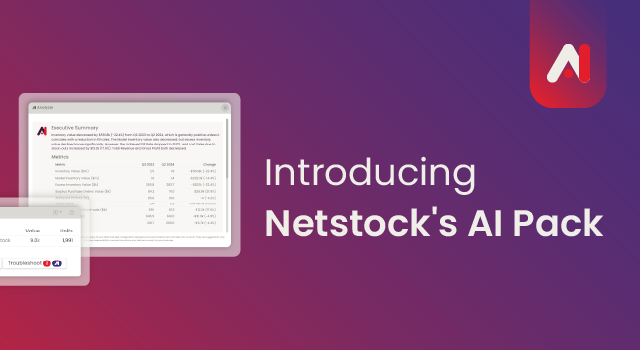Global supply chains and multi-channel sales have amplified business complexity and extended lead times. In this increasingly complex environment, inventory visibility becomes essential—planning with spreadsheets or manual processes simply can’t keep up.
Inventory visibility, which refers to monitoring inventories in real-time across various locations, can simplify matters. Under these conditions, data replaces excess inventories for continuous supply even as demand changes.Inventory visibility supports customer service excellence and reduces supply chain costs.
Modern integrated technologies offer unprecedented visibility. Barcode scanners, Radio Frequency Identification, and cloud-based demand and supply planning solutions enable supply chain visibility, automation, and collaboration.
It’s time to consider the benefits and challenges of improving your supply chain visibility. A small investment in time and technology will offer massive returns.
What is inventory visibility?
An efficient supply chain depends on high levels of inventory visibility. Visibility is all about understanding your inventory, what you have, where it is, how much you have on order, and how much is committed to sales.
Many businesses use inventory management software or Warehouse Management Systems (WMS) to achieve real-time visibility. The systems integrate with barcode scanners, Point of Sale, and other technologies to track inventory movements.
An online retailer, for example, can see inventory availability across all their warehouses. This means they can route orders to the closest location for the fastest and most cost-effective shipping options.
Sellers of perishable goods know where their produce is and when it will arrive. They can also track environmental conditions across transportation routes.
Benefits of improved inventory visibility
Businesses embracing new technologies can benefit from seamless supply chains and optimized inventories.
Reduced stock-outs and overstocks
When you know what you have, how much, where, and the status of every inventory item you keep, you can manage your stock more effectively. Accurate, current data ensures that you can avoid stock-outs without stockpiling. This frees up warehouse space and reduces costs. You can develop a reputation as a reliable supplier, ensuring satisfied customers will return to buy from you again.
With the Netstock dashboard, Best Vinyl was able to quickly identify stock-outs and potential stock-outs, leading to more focused conversations with their sales team about upcoming needs and strategic order placements. – Best Vinyl
Netstock can redistribute excess stock in a matter of minutes
Enhanced collaboration
Shared visibility ensures that all stakeholders work with the same information, improving coordination and efficiency throughout the supply chain. This unified approach reduces inventories and lead times. Suppliers can access your forecasts, enabling them to better plan their production and resource allocation. Overall, supply chain stakeholders benefit from enhanced communication and collaboration.
Increased profitability
Well-managed inventories increase profitability through cost savings, improved margins, and enhanced cash flow. Now, you can reduce your inventory levels. As a result, you need less warehouse space and your holding costs drop. Stock-outs become the exception, increasing your sales as you can meet customer demand.
Excess stock ties up capital. Reducing this stock frees up capital for other projects. You can also use the extra cash to reduce debts and save interest.
Optimized inventories also streamline warehouse operations, reducing labor requirements and speeding up order fulfillment. Theft, damage, and obsolescence should all come down as you reduce your inventories.
Improved order accuracy
Fulfilling orders is much easier when you know exactly what inventories you have. There should be no need for back orders as you can make accurate delivery promises. You can consolidate orders, reducing shipping costs. You can also pick and pack faster and more efficiently as all products are known and available. Customer satisfaction will increase and return customers will grow your business.
Supply chain agility
Companies can quickly adjust to demand fluctuations and supply chain disruptions, resulting in operational continuity. Organizations can also quickly respond to projected demand changes as they track real-time sales trends. More time to react enables more efficient resource allocation, saving costs and improving response times.
Planners can take action to prevent disruptions as supply chain problems are exposed earlier in the process.
Cost reduction
As you reduce excess stock, your inventory holding costs will decrease. Excess inventory occupies warehouse space. You must insure it, and you run the risk of damage and obsolescence. All of these costs come down as you shed the excess stock.
Aquatic AV cut inventory by over $1 million and boosted its customer fill rate from 79% to 99% with Netstock. Read more
Challenges of achieving inventory visibility
Achieving inventory visibility is challenging. You may encounter a few challenges along the way such as:
- Complex Supply Chains: Globalization and multi-tier supply chains make it difficult to get a clear picture of the inventories and their locations.
- Data Silos: Often functional departments use non-integrated software. Each department inputs their own data causing data silos and data inaccuracies.
- Technology Barriers: There may be companies along the supply chain without the technology to track inventory in real time.
- Change Management: Employees may resist attempts to install new systems and processes.
- Inadequate Legacy Systems: Older software platforms may not support real-time tracking and integration.
Tips & strategies for improving inventory visibility
Though you may face challenges, there are also several steps you can take to achieve inventory visibility benefits.
- Invest in the right technology: Choose scalable and user-friendly inventory management software. It must integrate well with your current systems to prevent data silos. Integrated systems are quicker and easier to maintain. Data is automatically transferred and training is simpler.
- Centralize data integration: Reduce errors by integrating the data on the different systems into a single source of truth.
- Update data in real-time: Your inventory data must be updated in real-time to ensure accurate information. It’s the only way to enable quick responses to supply chain changes.
- Leverage data analytics: Analytics tools can make large amounts of data more digestible. They can offer insights to help you understand inventory trends and patterns. Data analytics can also improve demand forecast accuracy to optimize inventory.
- Automate processes: Reduce labor costs and increase inventory accuracy by automating processes. Automated order placement can help you optimize your inventory levels. Integrated technologies, like barcode scanning, reduce human error.
- Collaborate with suppliers: Include suppliers in your inventory visibility project to reduce lead and improve delivery reliability.
Inventory visibility – the key to operational excellence
Inventory visibility drives operational efficiency, cost reductions, and customer service excellence. Your business can develop a clear, real-time view of your inventory across the supply chain by addressing the challenges and applying inventory best practices.





